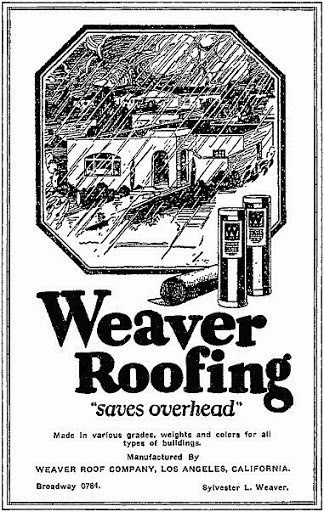
87 Fremont Place
PLEASE SEE OUR COMPANION HISTORIES
WILSHIRE BOULEVARD ADAMS BOULEVARD WINDSOR SQUAREHANCOCK PARK BERKELEY SQUARE ST. JAMES PARK
WESTMORELAND PLACE
FOR AN INTRODUCTION TO FREMONT PLACE, CLICK HERE
FOR AN INTRODUCTION TO FREMONT PLACE, CLICK HERE
Arriving in Los Angeles from the Midwest in 1895, Sylvester Laflin Weaver followed a common trajectory. While he wasn't a Joad escaping farm foreclosure—his namesake maternal grandfather was a prosperous gunpowder manufacturer in St. Louis with old New England roots—the good-looking Weaver, lean, red-headed, and blunt, did in short order work his way up from the factory floor to owning his own very large roofing company. As the Times described him in one of its "Sketches of Big Men in Industrial Life" published at the time of his move to Fremont Place, he also devoted tremendous energy to create modern Los Angeles. While part of a patriarchy later excoriated for exercising its prerogatives, it remains a fact that men like Weaver shaped modern urban America.
 |
| The developers of Fremont Place advertised their new subdivision as being one "For the Man of Means"; on December 2, 1923, a profile of one such man just moving to the tract appeared with this drawing in the Times. |
As a tireless civic booster, Sylvester Weaver served a number of stints as president of the Los Angeles Chamber of Commerce and, later, headed the All-Year Club, Southern California's national tourism promotion organization. In whatever group he became involved, it was unusual for him not to lead it; while he was merely on the board of directors of the Boy Scouts, he served terms as president of the Los Angeles Rotary Club and as director of both the California Development Association and the Better America Federation. As director of his own family, he was no slouch. He married and had four children, who appear to have been inspired by example. His son Sylvester Barnabee Weaver—later, perhaps in tribute to his father, styled as Sylvester L. Weaver Jr., and better known as Pat—became a hard-driving businessman himself; as an advertising executive in radio and president of NBC from 1953 to 1955, he is credited with creating the Today and Tonight shows, among other innovations in broadcasting. Pat's brother, whose real first name among five altogether was Winstead but who became known as the actor and comedian Doodles Weaver, had a considerable career but overall seems to have struggled in the big shadows of the other males in his family. Sylvester's granddaughter by Pat carried the family torch of accomplishment into a third generation as the actress Sigourney Weaver, who, born Susan, reversed the trademark family quirk of simplifying names.
 |
| "Saves overhead": As the Weavers prepared to move to Fremont Place, this advertisement appeared in the Times on August 30, 1923. |
Before graduating to Fremont Place, the Weavers—the Los Angeles originator Sylvester, Amabel, whom he'd married in Santa Barbara County in 1902, and their four children, neatly planned, girl, boy, girl, boy—were living in a bungalow at what is now 1811 South Norton Avenue, a house still there and in excellent repair (perhaps owing to a Weaver Roof) with a very tall palm in front, one perhaps even planted by the family. Number 87 Fremont Place was nevertheless a considerable step up from Norton Avenue near Washington Boulevard. City records cite a build date for the new house of 1923; while it is not clear as to whether Weaver commissioned the house himself, no doubt supplying the best of roofs, or bought one built on spec, social notes in the Times describe the family as being in residence at 87 at least by February 1924. There Mrs. Weaver entertained while her husband continued to roof and boost the city and young Sylvester went east to Dartmouth. The family would remain at 87 until not long after Amabel—exact diminutive unknown—died on March 16, 1939. A year later, on April 25, 1940, Rosemary Weaver was married to Paul Fritz, with a reception held at 87. Not long after, with his wife gone and children grown, Sylvester left Fremont Place and moved downtown to the Jonathan Club, where he had the distinction of being the holder of membership number 1.

